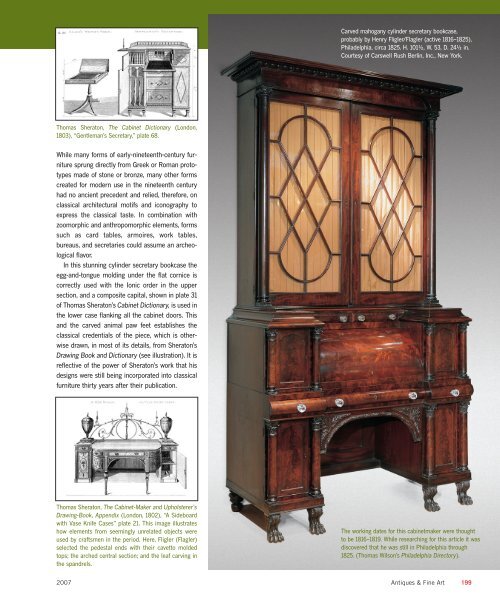by carswell rush berlin - Antiques and Fine Art
by carswell rush berlin - Antiques and Fine Art
by carswell rush berlin - Antiques and Fine Art
Create successful ePaper yourself
Turn your PDF publications into a flip-book with our unique Google optimized e-Paper software.
Thomas Sheraton, The Cabinet Dictionary (London,<br />
1803), “Gentleman’s Secretary,” plate 68.<br />
While many forms of early-nineteenth-century furniture<br />
sprung directly from Greek or Roman prototypes<br />
made of stone or bronze, many other forms<br />
created for modern use in the nineteenth century<br />
had no ancient precedent <strong>and</strong> relied, therefore, on<br />
classical architectural motifs <strong>and</strong> iconography to<br />
express the classical taste. In combination with<br />
zoomorphic <strong>and</strong> anthropomorphic elements, forms<br />
such as card tables, armoires, work tables,<br />
bureaus, <strong>and</strong> secretaries could assume an archeological<br />
flavor.<br />
In this stunning cylinder secretary bookcase the<br />
egg-<strong>and</strong>-tongue molding under the flat cornice is<br />
correctly used with the Ionic order in the upper<br />
section, <strong>and</strong> a composite capital, shown in plate 31<br />
of Thomas Sheraton’s Cabinet Dictionary, is used in<br />
the lower case flanking all the cabinet doors. This<br />
<strong>and</strong> the carved animal paw feet establishes the<br />
classical credentials of the piece, which is otherwise<br />
drawn, in most of its details, from Sheraton’s<br />
Drawing Book <strong>and</strong> Dictionary (see illustration). It is<br />
reflective of the power of Sheraton’s work that his<br />
designs were still being incorporated into classical<br />
furniture thirty years after their publication.<br />
Thomas Sheraton, The Cabinet-Maker <strong>and</strong> Upholsterer’s<br />
Drawing-Book, Appendix (London, 1802), “A Sideboard<br />
with Vase Knife Cases” plate 21. This image illustrates<br />
how elements from seemingly unrelated objects were<br />
used <strong>by</strong> craftsmen in the period. Here, Fligler (Flagler)<br />
selected the pedestal ends with their cavetto molded<br />
tops; the arched central section; <strong>and</strong> the leaf carving in<br />
the sp<strong>and</strong>rels.<br />
Carved mahogany cylinder secretary bookcase,<br />
probably <strong>by</strong> Henry Fligler/Flagler (active 1816–1825),<br />
Philadelphia, circa 1825. H. 101˙, W. 53, D. 24˙ in.<br />
Courtesy of Carswell Rush Berlin, Inc., New York.<br />
The working dates for this cabinetmaker were thought<br />
to be 1816–1819. While researching for this article it was<br />
discovered that he was still in Philadelphia through<br />
1825. (Thomas Wilson’s Philadelphia Directory).<br />
2007 <strong>Antiques</strong> & <strong>Fine</strong> <strong>Art</strong> 199




